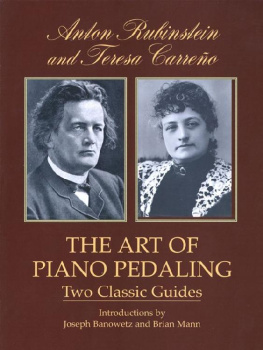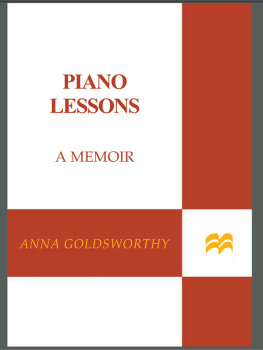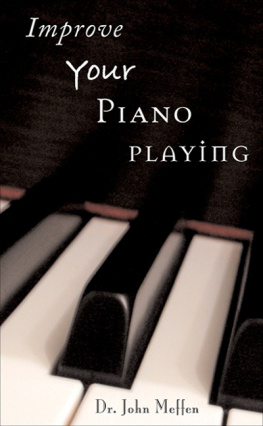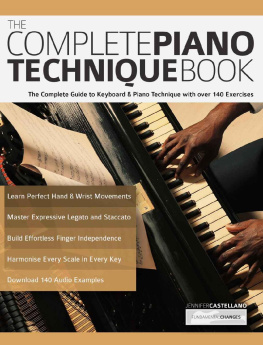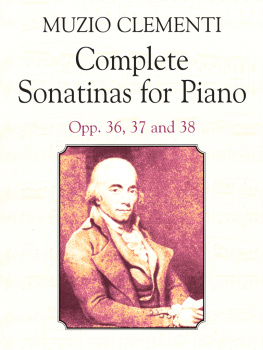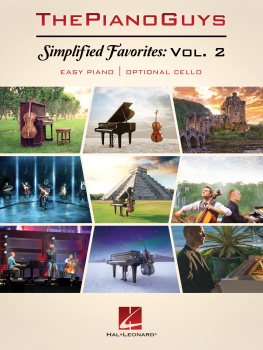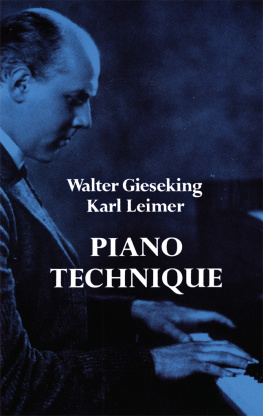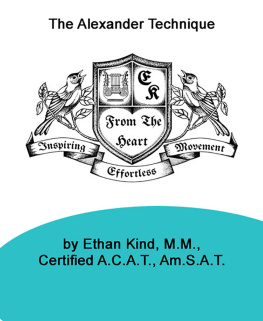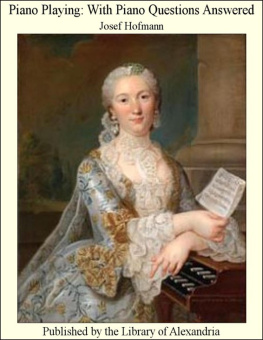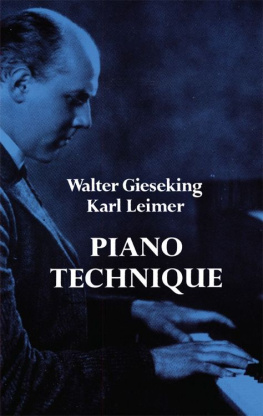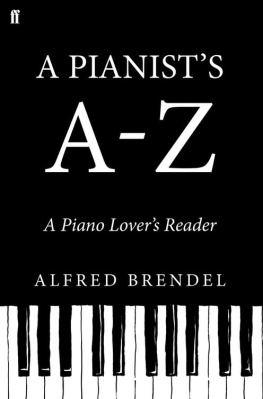Anton Rubinstein - The Art of Piano Pedaling: Two Classic Guides
Here you can read online Anton Rubinstein - The Art of Piano Pedaling: Two Classic Guides full text of the book (entire story) in english for free. Download pdf and epub, get meaning, cover and reviews about this ebook. year: 2013, publisher: Dover Publications, genre: Art. Description of the work, (preface) as well as reviews are available. Best literature library LitArk.com created for fans of good reading and offers a wide selection of genres:
Romance novel
Science fiction
Adventure
Detective
Science
History
Home and family
Prose
Art
Politics
Computer
Non-fiction
Religion
Business
Children
Humor
Choose a favorite category and find really read worthwhile books. Enjoy immersion in the world of imagination, feel the emotions of the characters or learn something new for yourself, make an fascinating discovery.
- Book:The Art of Piano Pedaling: Two Classic Guides
- Author:
- Publisher:Dover Publications
- Genre:
- Year:2013
- Rating:3 / 5
- Favourites:Add to favourites
- Your mark:
- 60
- 1
- 2
- 3
- 4
- 5
The Art of Piano Pedaling: Two Classic Guides: summary, description and annotation
We offer to read an annotation, description, summary or preface (depends on what the author of the book "The Art of Piano Pedaling: Two Classic Guides" wrote himself). If you haven't found the necessary information about the book — write in the comments, we will try to find it.
The Art of Piano Pedaling: Two Classic Guides — read online for free the complete book (whole text) full work
Below is the text of the book, divided by pages. System saving the place of the last page read, allows you to conveniently read the book "The Art of Piano Pedaling: Two Classic Guides" online for free, without having to search again every time where you left off. Put a bookmark, and you can go to the page where you finished reading at any time.
Font size:
Interval:
Bookmark:
THE ART OF PIANO PEDALING
Two Classic Guides
THE ART OF PIANO PEDALING
TWO CLASSIC GUIDES
Anton Rubinstein
and
Teresa Carreo
DOVER PUBLICATIONS, INC.
Mineola, New York
Warmest gratitude goes to the following friends of Joseph Banowetz, who aided enormously in helping to research his contribution to this volume: Donna Arnold, Natasha Bolshakova, Terry McNeill, Douglas Taylor, Marta Wodnicki, and the University of North Texas Music Library under the direction of Morris Martin.
Copyright
Copyright 2003 by Dover Publications, Inc.
All rights reserved.
Bibliographical Note
This Dover edition, first published in 2003, is a new compilation of two music texts: Guide to the Proper Use of the Pianoforte Pedals with Examples out of the Historical Concerts of Anton Rubinstein / Translated from the German text of [Alexander Nikitich] Bukhovstev by John A. Preston , as published by Bosworth & Co., Leipzig, [1897]; and Possibilities of Tone Color by Artistic Use of Pedals: The Mechanism and Action of the Pedals of the Piano , by Teresa Carreo, published by The John Church Company, New York [1919].
We are indebted to Joseph Banowetz and Brian Mann for bringing these classic texts to our attention, for providing rare materials for their republication, and for introductions to the two texts, written specially for this Dover edition.
International Standard Book Number: 0-486-42782-X
Manufactured in the United States by Courier Corporation
42782X04
www.doverpublications.com
Contents
CONCEPTS OF PIANO PEDALING
by Joseph Banowetz
THE WALKRE OF THE PIANO
by Brian Mann
GUIDE TO THE PROPER USE OF THE PIANOFORTE PEDALS
with Examples out of the Historical Concerts of Anton Rubinstein
POSSIBILITIES OF TONE COLOR BY ARTISTIC USE OF PEDALS
The Mechanism and Action of the Pedals of the Piano by Teresa Carreo

The more I play, the more I am thoroughly convinced that the pedal is the soul of the piano. There are cases where the pedal is everything.
Anton Rubinstein
Anton Rubinstein and Teresa Carreo remain two of pianisms legendary figures. Both still hold a charismatic fascination for musiciansRubinstein as Liszts only possible rival on the concert stage, Carreo as the foremost woman pianist of the late nineteenth century. Together they form a tradition of pianism that has profoundly influenced performers to the present day. Above all, their treatment of pedaling is of the utmost importance, not only from an historical standpoint but for what it can still teach even the most sophisticated player today.
Concepts of piano pedaling evolved rapidly and drastically since the time of Johann Nepomuk Hummel (1778-1837), who is known to have used little or no pedal in his concertsand termed it a sin-coverer! Even the now universally used legato or syncopated pedaling technique was until at least the last quarter of the nineteenth century still used infrequently, as opposed to an older form of so-called rhythmic pedaling, where the pedal was raised a split-second before a new change of harmony, then depressed simultaneously with it.
Moritz Rosenthal (18621946)who had studied first with Karl Mikuli (Chopins student and colleague), than with Franz Liszthad this to say about pedaling in the 15 October 1924 issue of the periodical Musical Life:
Anton Rubinstein was the first pianist I heard in public recital who used the pedal correctly. He originated the syncopated pedal. Every amateur knows today that the keys and pedal are not to be struck simultaneously. The tone is kept flowing by applying the pedal when the hands are raised, or there is no continuity of sound. Even Liszt achieved his triumphs in spite of a bad use of the pedal. The discovery of the syncopated pedal was the most important one in the history of playing. It was the emancipation of the wrist and arms from the keyboard. It brought an orchestral and cantilena playing that raised the piano to the highest rank among instruments.
Using specific examples from his recitals of 18856, Rubinsteins approach to pedaling is closely examined in the now-legendary Guide to the Proper Use of the Pianoforte Pedals , which appeared in Russia in 1896, written by Alexander Nikitich Bukhovtsev (18501897), a former piano student of Nikolay Rubinstein (Antons brother) at the Moscow Conservatory. The text was edited by Sergey Taneyev, who had taken over Nikolays piano class when he died in 1881. (Taneyev later became director of the conservatory.) Slightly later, editions in French and German by writer-conductor Maurice Kufferath soon appeared, followed in 1897 by an English translation from the German by John A. Preston.
The Guide quickly contrasts the older rhythmic pedaling technique with the newer legato form of pedaling, using the music from those historic recitals designed to explore the entire range of piano literature; in a few instances, the book also discusses the pedaling of Nikolay Rubinstein. This wealth of examples demonstrates an incredible range of imagination and sense of color, extraordinarily stimulating even when certain liberties seem to border on stylistic violations.
In a few instances, Rubinsteins own interpretations are stressed, as in the Marche funbre from Chopins Sonata No. 2. Here he uses varied lengths of pedaling to portray the approach and disappearance of the procession. Equally intriguing are remarks about the presto Finale of the sonata (altered to Prestissimo ) in which Rubinstein intended to imitate gusts of wind by a brief use of the pedal upon the descending scale. This runs counter to an article that quotes Moriz Rosenthal, where he recalls attending with Liszt an 1885 Rubinstein concert in Pressburg (now Bratislava). He describes the same dramatic piling-up of sonorities in the march, but contradicts the idea of sparse pedaling in the finale, saying that under the cover of thick pedaling, he let the tones fall pell-mell in wildly convulsive crescendos. (Both observers strongly felt Rubinsteins interpretation to be counter to Chopins intentions!)
Nikolaywhom many musicians of the day considered Antons equal at the keyboardwas similarly not above a free altering of a score for special effect. An example is the ending of the first movement of Beethovens Piano Sonata, Op. 31 no. 2, where the original dynamics are completely changed! Such a free-wheeling approach to the written text is still a part of the Russian School in some quarters.
Occasional stylistic questions of interpretation aside, there is no doubt that Rubinsteins ideas on pedaling were far ahead of his time. In 1875, even Lisztas if encountering a new ideawrote in a letter to pedagogue Louis Khler: The entrance of the pedal after the striking of the chords is much to be recommended, especially in slow tempi.
________________________________________________
Teresa Carreos pedaling text was still in preparation at the time of her death in 1917, and was published in 1919 with a preface by her student, Adelaide C. Okell. This perhaps explains the sparse contents of concluding Chapter VIII.
Writing in a warm, non-academic style, Carreo stresses several points of particular interest. From the outset she insists that the touch, not the pedals, should be the determining factor in both loud and soft playing. At times she seems to be extremely sensitive to the faint repetition of tone that occurs when the dampers are raised, then again lowered after a change of harmony. To remedy this, she asks for a near-simultaneous depression of the pedal with a new harmony. At other times, she asks for a pedal crescendo with a delayed re-depression of the pedal, to enhance and strengthen a loud chord.
Carreo seems intensely concerned with color and touch, and strongly emphasizes the importance of achieving a real legato, and of holding notes with the fingers for their full duration. She also comments on her pedal diminuendothat is, tapering ends of phrases with the pedal. Although there are occasional holdovers from the early rhythmic form of pedaling, her text shows great sensitivity to color and shading, and many of her observations remain relevant, enlightening, and provocative for todays musician.
Next pageFont size:
Interval:
Bookmark:
Similar books «The Art of Piano Pedaling: Two Classic Guides»
Look at similar books to The Art of Piano Pedaling: Two Classic Guides. We have selected literature similar in name and meaning in the hope of providing readers with more options to find new, interesting, not yet read works.
Discussion, reviews of the book The Art of Piano Pedaling: Two Classic Guides and just readers' own opinions. Leave your comments, write what you think about the work, its meaning or the main characters. Specify what exactly you liked and what you didn't like, and why you think so.

